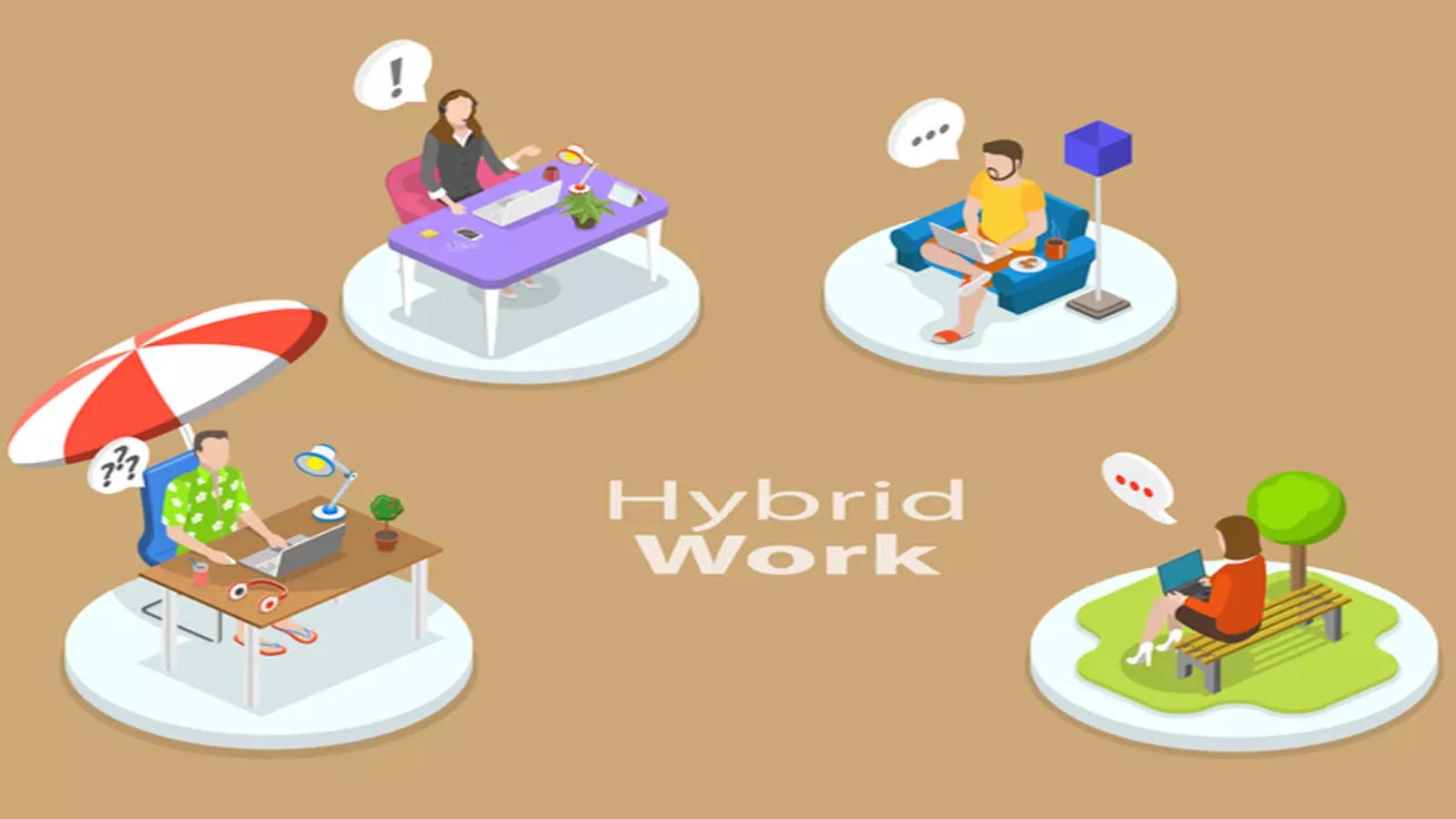Hybrid Model In the wake of unprecedented technological advancements and shifting workplace dynamics, the traditional model of work has undergone a profound transformation. Enter the hybrid model—a flexible approach that blends remote and in-person work to accommodate the diverse needs and preferences of modern workers. In this article, we’ll explore the intricacies of hybrid models, examine their benefits and challenges, and consider their implications for the future of work.

Understanding the Hybrid Model:
The hybrid model, also known as hybrid work or hybrid remote work, combines elements of remote work and in-person work to create a flexible and adaptable work environment. Unlike traditional office-based models, which require employees to be physically present in a central location, the hybrid model allows individuals to work remotely part of the time while also maintaining opportunities for in-person collaboration and engagement.
Key Features of Hybrid Models:
Contents
- Flexibility: Hybrid models offer flexibility in terms of where and when work is performed. Employees have the freedom to choose between working remotely and coming into the office, allowing them to balance work responsibilities with personal commitments and preferences.
- Remote Connectivity: Hybrid models leverage technology to facilitate seamless communication and collaboration among remote and in-person team members. Video conferencing, instant messaging, and project management tools enable virtual meetings, file sharing, and real-time collaboration regardless of physical location.
- Office Space Optimization: With a hybrid model, organizations can optimize their use of office space by implementing flexible desk arrangements, hot-desking policies, or shared workspaces. This allows companies to reduce overhead costs associated with maintaining large office spaces while still providing a physical hub for collaboration and interaction.
- Employee Autonomy: Hybrid models empower employees to take ownership of their work schedules and environments, fostering a sense of autonomy and empowerment. Individuals have the flexibility to tailor their work arrangements to suit their personal preferences, productivity rhythms, and work-life balance needs.
Benefits of Hybrid Models:
- Enhanced Work-Life Balance: Hybrid models offer employees greater flexibility and autonomy over their work schedules, allowing them to better balance professional responsibilities with personal obligations and interests.
- Increased Productivity: Remote work can eliminate time-consuming commutes and office distractions, allowing employees to focus on tasks with greater efficiency and concentration. Studies have shown that remote workers often report higher levels of productivity and job satisfaction.
- Expanded Talent Pool: By embracing remote work options, organizations can tap into a broader talent pool beyond geographical boundaries. Remote hiring allows companies to recruit top talent from diverse locations, regardless of proximity to physical office locations.
- Cost Savings: Hybrid models can result in cost savings for both employers and employees. Companies can reduce expenses related to office space, utilities, and overhead, while employees may save on commuting costs, wardrobe expenses, and dining out.

Challenges of Hybrid Models:
- Communication and Collaboration: Hybrid models may present challenges related to communication and collaboration, particularly when team members are dispersed across different locations and time zones. Maintaining effective communication channels and fostering a sense of connection among remote and in-person colleagues is essential.
- Managerial Oversight: Managing hybrid teams requires strong leadership and effective management practices to ensure that employees remain engaged, motivated, and productive. Managers must adapt their leadership styles to accommodate remote work dynamics and provide support and guidance to remote team members.
- Workplace Culture: Hybrid models may pose challenges to maintaining a cohesive workplace culture and sense of community. Organizations must find ways to foster a strong sense of belonging and connection among remote and in-person employees, such as virtual team-building activities, regular check-ins, and inclusive communication practices.
- Technological Infrastructure: Implementing hybrid work models requires robust technological infrastructure to support remote collaboration, data security, and IT support. Organizations must invest in reliable communication tools, cybersecurity measures, and remote access solutions to ensure smooth operations and data protection.
The hybrid model represents a paradigm shift in the way we work, offering flexibility, autonomy, and adaptability in an ever-evolving landscape. While hybrid models present numerous benefits in terms of work-life balance, productivity, talent acquisition, and cost savings, they also pose challenges related to communication, management, workplace culture, and technological infrastructure. By embracing hybrid work models and addressing these challenges proactively, organizations can create a more resilient, inclusive, and sustainable future of work that meets the diverse needs of employees and fosters innovation, collaboration, and success.
Hybrid work models have emerged as a flexible solution to accommodate the evolving needs and preferences of today’s workforce. By combining elements of remote and in-person work, hybrid models togelup login offer a middle ground that provides employees with greater flexibility while still maintaining opportunities for collaboration and engagement. In this article, we’ll explore the advantages and disadvantages of hybrid work models, shedding light on their complexities and implications for the future of work.

Advantages of Hybrid Work Models:
- Flexibility: One of the primary advantages of hybrid work models is their flexibility. Employees have the autonomy to choose when and where they work, allowing them to balance professional responsibilities with personal obligations and preferences. This flexibility promotes greater work-life balance and can contribute to increased job satisfaction and well-being.
- Cost Savings: Hybrid work models can result in cost savings for both employers and employees. Companies can reduce expenses associated with office space, utilities, and overhead, while employees may save on commuting costs, wardrobe expenses, and dining out. These cost savings can translate into increased profitability for businesses and improved financial stability for individuals.
- Expanded Talent Pool: By embracing remote work options, organizations can tap into a broader talent pool beyond geographical boundaries. Remote hiring allows companies to recruit top talent from diverse locations, regardless of proximity to physical office locations. This expanded talent pool increases the potential for innovation, creativity, and diversity within the workforce.
- Productivity and Performance: Remote work has been associated with higher levels of productivity and job performance for many employees. Without the distractions and interruptions often present in traditional office settings, remote workers can focus on tasks with greater efficiency and concentration, leading to improved outcomes and results.
- Employee Satisfaction and Retention: Offering flexibility and autonomy through hybrid work models can enhance employee satisfaction and retention rates. Employees who have the flexibility to manage their work schedules and environments are more likely to feel valued, motivated, and engaged, leading to higher levels of loyalty and commitment to their organizations.
Disadvantages of Hybrid Work Models:
- Communication and Collaboration Challenges: Hybrid work models may pose challenges related to communication and collaboration, particularly when team members are dispersed across different locations and time zones. Maintaining effective communication channels and fostering a sense of connection among remote and in-person colleagues requires deliberate effort and coordination.
- Managerial Oversight: Managing hybrid teams requires strong leadership and effective management practices to ensure that employees remain engaged, motivated, and productive. Managers must adapt their leadership styles to accommodate remote work dynamics and provide support and guidance to remote team members.
- Workplace Culture: Hybrid work models may impact workplace culture and camaraderie, as employees may have fewer opportunities for spontaneous interactions and face-to-face collaboration. Building and maintaining a cohesive workplace culture in a hybrid environment requires intentional efforts to foster connection, trust, and camaraderie among team members.
- Technology and Infrastructure Requirements: Implementing hybrid work models necessitates robust technological infrastructure to support remote collaboration, data security, and IT support. Organizations must invest in reliable communication tools, cybersecurity measures, and remote access solutions to ensure smooth operations and data protection.
- Inequities and Accessibility Concerns: Hybrid work models may exacerbate inequities and accessibility concerns, particularly for employees with limited access to technology, reliable internet connectivity, or suitable home workspaces. Organizations must address these disparities proactively to ensure that all employees have equal opportunities to thrive in a hybrid work environment.
Conclusion:
Hybrid work models offer numerous benefits in terms of flexibility, cost savings, talent acquisition, productivity, and employee satisfaction. However, they also present challenges related to communication, managerial oversight, workplace culture, technology, and accessibility. By carefully navigating these advantages and disadvantages, organizations can leverage hybrid work models to create a more resilient, inclusive, and adaptable workplace that meets the diverse needs of employees and fosters innovation, collaboration, and success in the digital age.
Read More Article About “REVOLUTION HEALTH: EMBRACING A NEW ERA OF WELLNESS 2024“





